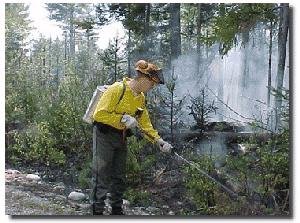
*Wild Land Fire Behavior*
Basic Concepts
By Eli
13 May 2003
This is article 1 of 2. This is covering fire behavior and the 2nd article will cover suppressing it and strategies you can use to defend your homestead/retreat from a wild land fire.
This article follows along with Freya’s. When she came up with the idea I asked if she wanted do a joint article. She had a better idea. She’d cover more on preventing a wildfire from reaching your homestead or retreat and I’d cover the tactics and concepts of fighting it from a firefighter’s perspective. Sounded good to me, so here it goes. I’m not getting technical and really really in depth. I’m going to try to keep this simple and oriented to "what you as a Rubie would have to work with" and not what we as firefighters have to work with. First you need to understand a little about how wild land fires work.

Maine Forest Ranger mopping up after a woods fire
Had to swipe the pic from MEFS website. We ain’t had no woods fires this year.
(http://www.state.me.us/doc/mfs/mfshome.htm)
(http://www.state.me.us/doc/mfs/art/photos/7.gif)
Fire has been around since the beginning of time, yet it has not been mastered although progress has been made trying to prevent fires and control fires.
When it comes to wild land fires there are 3 key things that affect it.
Radiation- stand next to a fire and you get warm, this is radiant heat
Convection- hot gasses and embers form a smoke column heating things above just like a chimney
Conduction- Heat is conducted from one fuel particle to another by physical contact.
Light Fuels
Shubs, grasses, leaves and pine needles (any fuel having a diameter of ½" or less). They burn rapidly and are quickly ignited because they are surrounded by oxygen. Fires in light fuels spread rapidly but burn out quickly and are easy to extinguish with the correct apparatus.
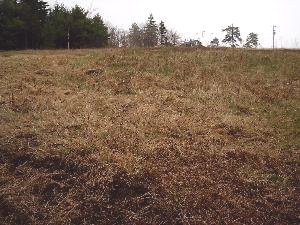
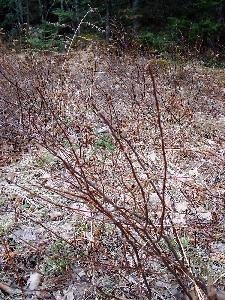
Light fuels- close to the ground and small
Heavy Fuels
Limbs, logs, tree trunks and large items on or near the ground. They warm slower than light fuels and the interiors are exposed to oxygen only after the outside is burned off. Once they begin to burn extinguishing them is more difficult.
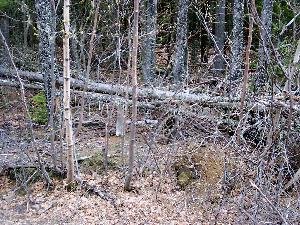
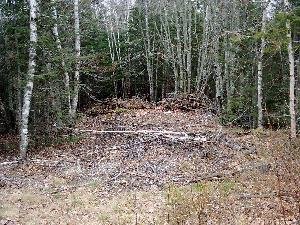
Heavy fuels
Uniform Fuels
Include all fuels distributed continuously over the area. Areas containing a network of fuels which connect with each other to provide a continuous path for a fire to spread are also included in this category.
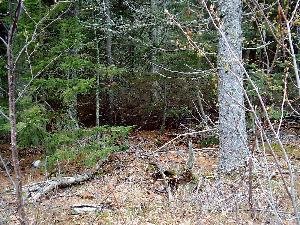
Uniform fuels (trees standing)- some heavy fuels on the ground
Patchy Fuels
Include all fuels distributed unevenly over the area. Scattered trees, scattered light & heavy fuels.
Ground fuels- lie beneath the surface… roots, rotten buried logs etc
Surface fuels- lie on or immediately above the ground
Aerial fuels- located in the upper canopy such as standing trees.
Weather is another big player with fire behavior. Cold & warm fronts, barometric pressure and thunderheads are a few influences.
Warm temperature heats and dries the fuel and reduces (bad) the fuel moisture (amount of water in a fuel)
Wind increases the supply of oxygen, influences the direction of the fire, dries fuels, carries sparks ahead of the main fire causing spot fires, moves heated air from convection heat transfer to downwind fuels.
Relatively Humidity is the ratio of the amount of moisture in the air to the amount which the air could hold at the same temp and pressure if it were saturated. It’s better to have high humidity while fighting a fire (other than it being hot and muggy due to fatigue and heat stroke or other heat related medical emergencies) because it makes the fuels moist. Low humidity dries it out quicker.
Precipitation is your friend. It puts moisture on the fuels and the light fuels will soak it up hence making them harder to burn. It doesn’t affect heavy fuels as much because the water isn’t absorbed as quick.
If you live in canyon type terrain or on a slope with fuels below you and there is a fire, GET THE HELL OUT! You will not be able to stop the fire from advancing. If you stay to try and save your house, you probably just signed your death warrant!!!! Many firefighters have died on slopes and in canyons. The fire is unpredictable and you CAN NOT control it!!! Remember earlier when I said that fire has not been mastered?
The lay of the land is very important. Slopes, aspects, box canyons, canyon & chimneys. The side of a mountain that is hit by the sun more often than the other side will be drier and burn faster than the other. Fire will burn quickly uphill (slope). Fuels higher up the hill will preheat from radiant & convection heat. Wind will carry cinders and sparks up the hill and ignite another fire. Burning material can roll down the slope and ignite fires below you. A fire in a canyon is not the place you want to be either. As a fire burns up one side and causes spot fires, radiant heat is also warming the opposite side. The fire can "spot" and sparks will ignite the other side. There could be a gully that goes up the side of a slope. This will create the "chimney affect" just like how a chimney works in a house. The fire will suck up the gully faster than a slope.
The lay of the land plays a HUGE roll in fire behavior.
There are some of the basics of a wild land fire. There is A LOT more to it, but I’ve tried to keep this simple, so hopefully this gave you a basic understanding of some of the major points.
Eli
All materials at this site not otherwise credited are Copyright (c) 1996-2003 Trip Williams. All rights reserved. May be reproduced for personal use only. Use of any material contained herein is subject to stated terms or written permission.